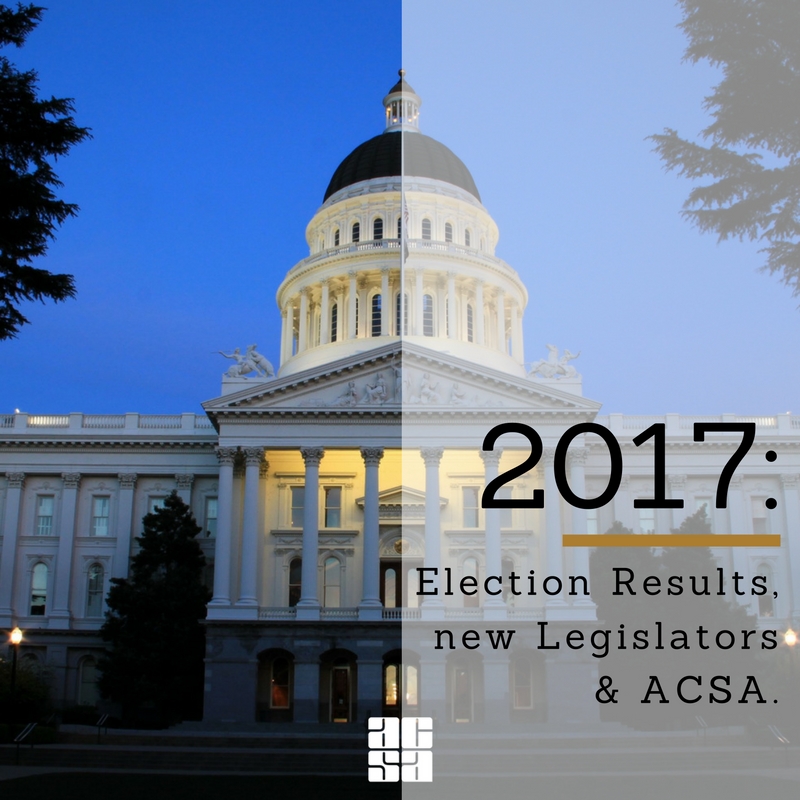New Legislators Elected
On November 8, the election everyone was waiting for finally took place. For some the result was shocking and for others it was to be expected in a year when the Chicago Cubs won the World Series. Amidst the excitement of the presidential election was an extraordinary California election that featured 17 ballot initiatives, 25 legislative races without an incumbent running and the first open US Senate seat in 24 years. All of these items lead to an election day that we may not see the likes of again for at least a decade.
Legislative Races
This election cycle offered some unique opportunities for stakeholders and special interest groups to not only be actively involved in shaping California’s Legislature, but to also align themselves within specific party factions. Additionally, the implementation of legislative term limits forced a cadre of legislators to be termed out of office and opened up their seats for new candidates to obtain their seat in the legislature. This year there were 25 open seats and a mad scramble as massive funding was used to help or hinder candidates in races across the state.
This summer and fall we saw stakeholders compete with each other to elect candidates who support their specific interests. There were serious legislative races that pit environmentalists against oil companies and charter school supporters against labor unions, just to name a few. Each group invested vast resources to ensure that their interests were represented in the state capitol. As the finance reporting trickled in leading up to November 8th, independent spending for legislative races reached approximately $43 million. For example, the California Charter School Association invested over $7 million in seven legislative races to help elect candidates to the legislature. These CCSA-influenced races include the successes of Marc Berman (Assembly District 24), Tim Grayson (AD 14), Madison Nguyen (AD 27), Anna Caballero (AD 30), Laura Friedman (AD 43) and Scott Wiener (SD 11). This effort was only matched by the resources spent by the gas and oil companies who spent an estimate of $4 million on legislative races alone
The 2016 election also saw many incumbents who faced substantive challenges. Assemblymember Steinorth (Assembly District 40), Assemblymember David Hadley (AD 66), Assemblymember Patty Lopez (AD 39), Assembly member Young Kim (AD 65), Assemblymember Catherine Baker (AD 16), Assemblymember Cheryl Brown (AD 47) and Assemblymember Eric Linder (AD 60) were all sitting members of the legislature who ran against heavily supported candidates.
While Assemblymembers Steinorth and Baker were successful in defending their challenges, Assemblymembers Hadley, Lopez, Linder, Kim and Brown were not able to retain their seats. Lopez and Brown each faced challengers from within the Democratic Party, resulting in Dem on Dem face-offs in the General election. Conversely, Republicans Kim, Hadley, and Linder were challenged by Democrats in the General, creating the opportunity for several districts to change hands within the legislature. Ultimately, former Assemblymember Sharon Quirk-Silva beat Young Kim in Assembly District 65, former Assemblymember Al Muratsuchi beat Assemblymember David Hadley, and a new candidate, Sabrina Cervantes beat Eric Linder. These wins by Democrats ensured that the Assembly Democrats will once again hold a supermajority in the Assembly starting in 2017.
As we wrap up final efforts to count ballots, it is still up in the air if the Senate Democrats will have the same good fortune as their collogues in the Assembly. While the Senate Democrats only needed to secure one additional legislative district from the few open legislative Senate seats and competitive races, the Senate has so far maintained the status quo of Republicans to Democrats. The open Senate seats included Senate District 4 (a Dem vs. Dem seat, won by Assemblymember Bill Dodd), SD 9 (another Democratic seat won by former Assemblymember Nancy Skinner), SD 11 (won by Democrat Scott Weiner), SD 25 (won by former Assemblymember Anthony Portantino), SD 27 (won by Democrat Henry Stern), and SD 35 (won by Stephen Bradford) and SD 39 (won by former Assembly Speaker Toni Atkins). The remaining open seat was won by a Republican - SD 21 was won by Assemblymember Scott Wilk.
The final ballot count remains to be reported in Senate District 29, as the highly contested race between Republican Assemblymember Ling Ling Chang and Democrat Josh Newman comes down to the very last absentee ballots. Therefore, we have a definite Super Majority in the Assembly, and still the possibility of a Super Majority in the Senate as well.
ACSA was very successful in our endorsements of candidates, with 82% winning their legislative races. You can find the candidates that ACSA endorsed and the result of their legislative race here.
ACSA Perspective
The next several months will be interesting with the inclusion of the new members to the State Legislature. This will begin with the new members taking the oath of office the first week of December. The majority of members will have very little if any experience with public education. Therefore, the onus will be on ACSA to educatethe new legislators on public education and nuances of educating our state’s 6 million students. Furthermore, the investments made by charter school advocates, oil and gas companies and the business community is slowing chipping away at the liberal nature of the Legislature. There were far more individuals elected to office this year that have the potential to be more moderate and less labor friendly than in past elections.
Every election offers the opportunity to develop new relationships, enhance existing ones and pursue new legislative opportunities. In the coming months ACSA will pursue every opportunity to be politically active and continue to implement legislative polices that support students.

